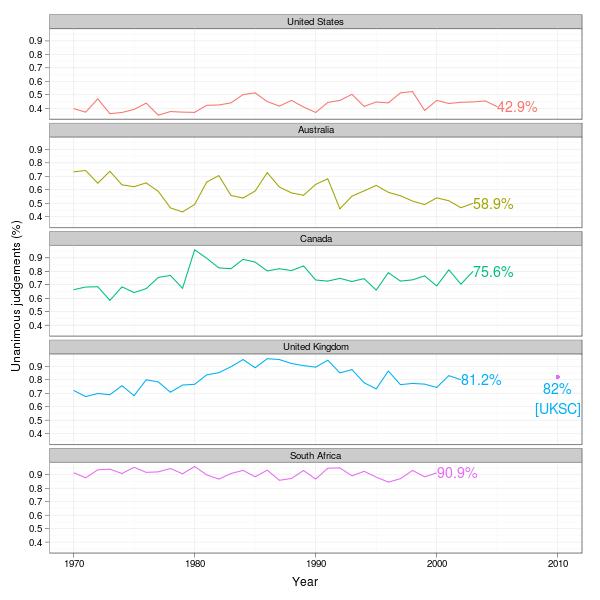Dissenting opinions in the UKSC
19 Thursday Aug 2010
Chris Hanretty, University of East Anglia Features
Share it
 Most journalists don’t care much about the law. The finer points of multiple concurring opinions are hardly catnip for the press corps — if indeed one can talk of a corps covering the UK Supreme Court rather than a few isolated snipers. If the Supreme Court is ever to gain widespread media attention — and commentators have noted just how difficult this is — it will be through high-profile split decisions.
Most journalists don’t care much about the law. The finer points of multiple concurring opinions are hardly catnip for the press corps — if indeed one can talk of a corps covering the UK Supreme Court rather than a few isolated snipers. If the Supreme Court is ever to gain widespread media attention — and commentators have noted just how difficult this is — it will be through high-profile split decisions.
Bare majorities on the court, such as the 5-4 split seen in JFS, are rather exciting to the outsider who knows nothing about the law (and I include myself amongst that number). Put crudely, they provide a score-line, and aid a narrative of the court as engaged in a battle between sides, rather than a collaborative effort to divine the meaning of the law, whatever that might be.
There are good reasons for thinking that the new UKSC ought to be more dissentient than the Judicial Committee of the House of Lords. More judgments are heard by more judges, and research has shown that larger bench sizes tend to produce more dissenting opinions. The composition of the court is more consistent, and the circulation of draft opinions seems to be more extensive, both factors which could either promote consensus or, should a draft opinion strike a bum note, end up polarizing justices and creating clear lines of demarcation.
At the same time, we can overstate the reasons for change. The court’s preference for a single majority opinion in preference to the seriatim judgments of old seems, to me, to demonstrate a preference for unanimity in order to strengthen the authority of the new court. Most of the justices on the Court came from the Lords. And the kind of claims possible within the various British legal systems do not seem, on the face of it, to be as likely to provoke dissent as the claims possible in other jurisdictions with constitutionally protected rights.
The graph below helps us tackle the issue. It shows the percentage of unanimous decisions for five different courts — the House of Lords, the US and Canadian Supreme Courts, the Australian High Court, and the South African Supreme Court of Appeal and, from 1995, the Constitutional Court. The graph is based on data collected by a number of political scientists in each of these jurisdictions, and are broadly comparable. Note that unanimous decisions are decisions where no judge dissented with respect to the outcome of the appeal; they may include separate judgments which concur in the outcome but disagree over the ratio decidendi. Occasionally this ignores significant differences in opinion between judges (Smith v Secretary of State for Defence [2010] UKSC 29 being one good example).
As the graph shows, the House of Lords, as was, displays much greater comity than its Canadian, Australian or American counterparts, and is only bested in the percentage of unanimous decisions by the South African courts. On average, about one case in five results in a dissenting opinion, but this ratio has changed over time, with fewer dissenting opinions in the eighties against relatively more in the seventies.
How then does the new UKSC compare to the House of Lords? Well, out of the fifty-seven judgments reported on BAILII, ten involved a dissenting opinion, meaning 82% of decisions were unanimous — almost exactly the same percentage found in the House of Lords. (Marked by the dot on the graph).
Admittedly, some of the dissents registered by the new court are more significant than others, with bare majorities of 5 to 4 (JFS), 4 to 3 (R (Electoral Commission) v City of Westminster Magistrates Court & UKIP [2010] UKSC 40; R (Sainsbury’s Supermarkets Ltd) v Wolverhampton City Council [2010] UKSC 20), and 3 to 2 (Star Energy Weald Basin Ltd & Anor v Bocardo SA [2010] UKSC 35; Martin v HM Advocate [2010] UKSC 10). But unless these cases are portents of greater dissentience down the road, it seems that the UKSC has continued in the same path ploughed by the House of Lords.
Chris Hanretty is Lecturer in Politics at the University of East Anglia. This article was originally posted on his blog.




7 comments
Anthony Fairclough said:
19/08/2010 at 09:44
JFS wasn’t a straightforward 5-4 split though. Lords Hope and Walker (in the minority) would have dismissed the appeal on the ground that JFS had indirectly discriminated against the claimant. So seven Justices felt there had been discrimination of some form.
David said:
26/08/2010 at 03:57
Probably worth noting that the unanimity rate on the High Court of Australia is now much higher than it was between 1996 and 2009 when Kirby J was around. His rate of dissent was unprecedented in High Court history.